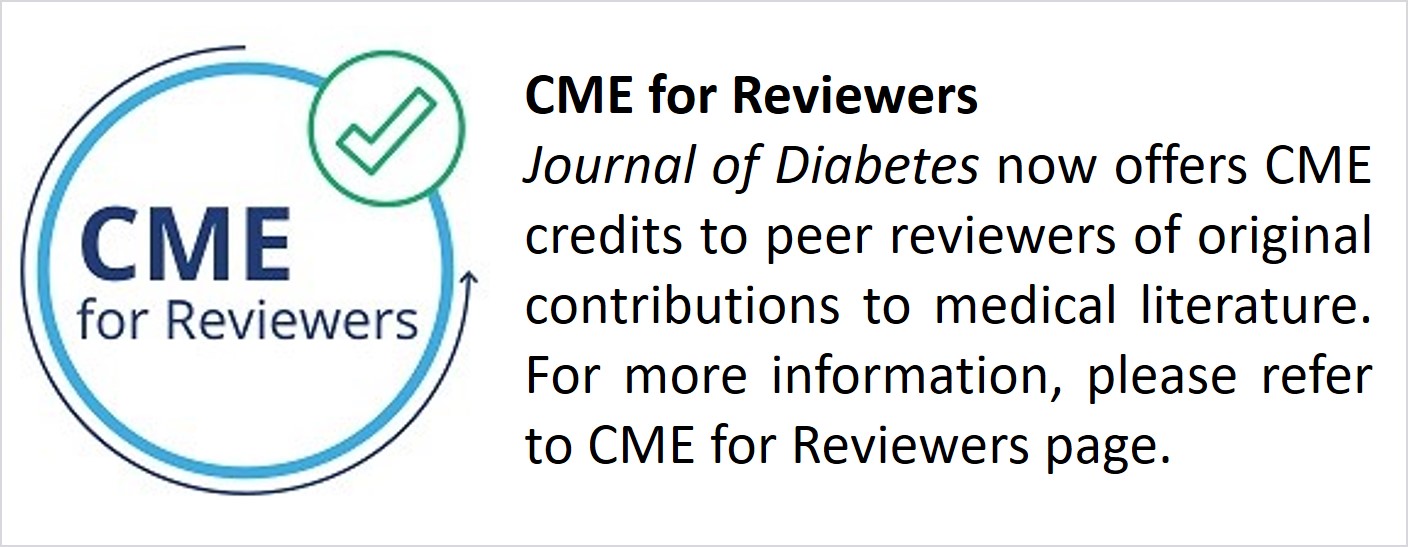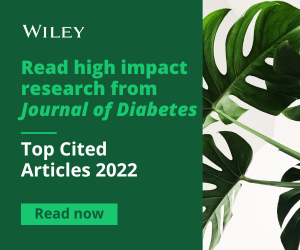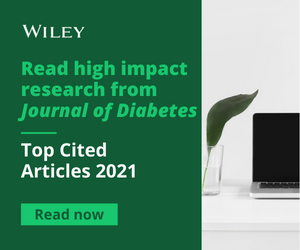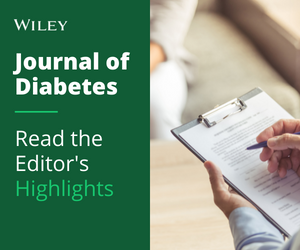Journal list menu
Export Citations
Top Cited Articles 2020
COVID-19 and comorbidities: A role for dipeptidyl peptidase 4 (DPP4) in disease severity?
新冠肺炎与合并症:二肽基肽酶4在疾病严重程度中的作用?
- First Published: 11 May 2020

Highlights
- Coronavirus disease 2019 (COVID-19) is caused by SARS-CoV-2; recent modeling of the structure of SARS-CoV-2 spike glycoprotein, which mediates viral-host-cell entry, predicts interactions with dipeptidyl peptidase 4 (DPP4) in addition to angiotensin-converting enzyme 2.
- Increased DPP4 expression and activity are associated with diabetes, obesity, and metabolic syndrome, all of which have been reported to influence COVID-19 severity.
- DPP4 inhibitors (gliptins), which vary in their interactions with the active site of the enzyme, may have immunomodulatory and cardioprotective effects that could be beneficial in COVID-19 cases.
Factors leading to high morbidity and mortality of COVID-19 in patients with type 2 diabetes
导致2型糖尿病患者新冠肺炎高发病率和高病死率的因素
- First Published: 16 July 2020

Highlights
- Type 2 diabetes mellitus (T2DM) is associated with chronic inflammation due to underlying insulin resistance and other comorbidities including obesity, older age, hypertension, cardiovascular disease, and dyslipidemia.
- Insulin resistance, hyperglycemia, and elevated angiotensin-converting enzyme 2 (which acts as cellular “receptor” for the virus) leads to heightened inflammation in T2DM.
- We hypothesize that exacerbation of preexisting chronic inflammation and the intense hyperimmune response (“cytokine storm”) play a critical role in increased morbidity and mortality of coronavirus disease 2019 (COVID-19).
- Safe and rigorous blood glucose, blood pressure, and lipid control is recommended in patients with T2DM and COVID-19.
Care for diabetes with COVID-19: Advice from China
糖尿病合并COVID-19的管理:来自中国的建议
- First Published: 13 April 2020
Identification of stress-related microRNA biomarkers in type 2 diabetes mellitus: A systematic review and meta-analysis
2型糖尿病的应激相关microRNA标志物:系统综述与meta分析
- First Published: 17 January 2018
Diabetes mellitus association with coronavirus disease 2019 (COVID-19) severity and mortality: A pooled analysis
糖尿病与冠状病毒病2019(COVID-19)的严重程度和死亡率的关联:汇总分析
- First Published: 16 July 2020

Highlights
- There are ~ 2-fold increased odds of severe coronavirus disease 2019 (COVID-19) and a ~ 2-fold increased risk of odds of mortality in patients with history of diabetes mellitus compared to those without diabetes mellitus.
- Patients with a history of diabetes mellitus should be closely monitored if they get infected with COVID-19.
Results of meta-analysis showing association of diabetes mellitus with severity (Panel A) of disease and mortality (Panel B) in coronavirus disease 2019 (COVID-19) patients
The impact of type 2 diabetes and its management on the prognosis of patients with severe COVID-19
2型糖尿病及其治疗对COVID-19重症患者预后的影响
- First Published: 08 July 2020

Highlights
- Type 2 diabetes mellitus (T2DM) patients with severe acute respiratory syndrome coronavirus 2 infection had more severe inflammation, coagulation activation, myocardia injury, hepatic injury, and kidney injury. T2DM aggravated the clinical status of coronavirus disease 2019 (COVID-19) patients and increased their critical illness rate and mortality.
- Glucocorticoid treatment and poor fasting blood glucose (≥11.1 mmol/L) control were found to be risk factors of fatality in T2DM patients with severe COVID-19.
Antihyperglycemic properties of hydroxychloroquine in patients with diabetes: Risks and benefits at the time of COVID-19 pandemic
在新冠肺炎大流行期间, 羟基氯喹对糖尿病患者降糖作用的风险和益处
- First Published: 13 May 2020

Highlights
- Hydroxychloroquine (HCQ) has been shown to exert antihyperglycemic properties by virtue of potential multifaceted effects on glucose homeostasis, including improvement of insulin sensitivity, increase of insulin secretion, and reduction of systemic inflammation.
- Preliminary studies have shown the safety and efficacy of HCQ as an antihyperglycemic agent in type 2 diabetes over a short-term period.
- A careful risk-benefit assessment of HCQ is critical for a cautious use of this drug in diabetic patients, particularly in light of the current COVID-19 pandemic.
Is newly diagnosed diabetes a stronger risk factor than pre-existing diabetes for COVID-19 severity?
与既往糖尿病相比,新诊断的糖尿病是否是新冠肺炎严重程度的更强危险因素?
- First Published: 27 October 2020
Increased DKA at presentation among newly diagnosed type 1 diabetes patients with or without COVID-19: Data from a multi-site surveillance registry
来自多监测点的数据:无论有没有新冠肺炎, 新发的1型糖尿病患者在就诊时DKA增加
- First Published: 07 December 2020

Highlights
- Our multicenter study reports a higher proportion of diabetic ketoacidosis presentation of over 60% in newly diagnosed patients with type 1 diabetes with or without confirmed coronavirus disease 2019 (COVID-19) at diagnosis.
- This finding is suggestive of delays in seeking care during the COVID-19 pandemic.









